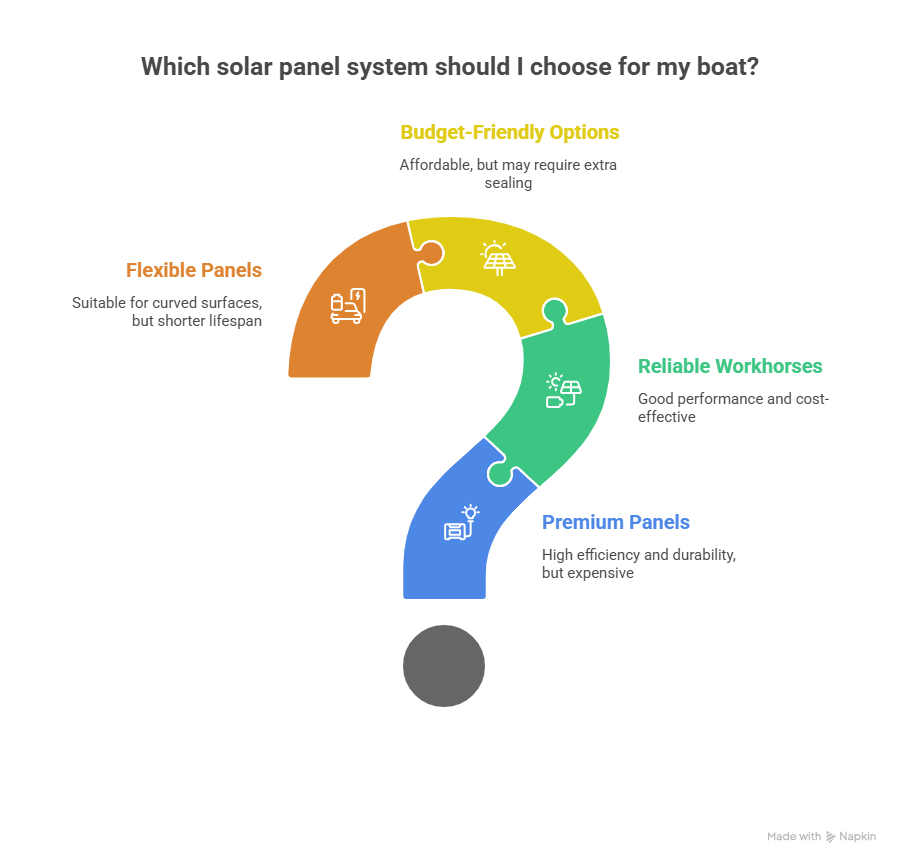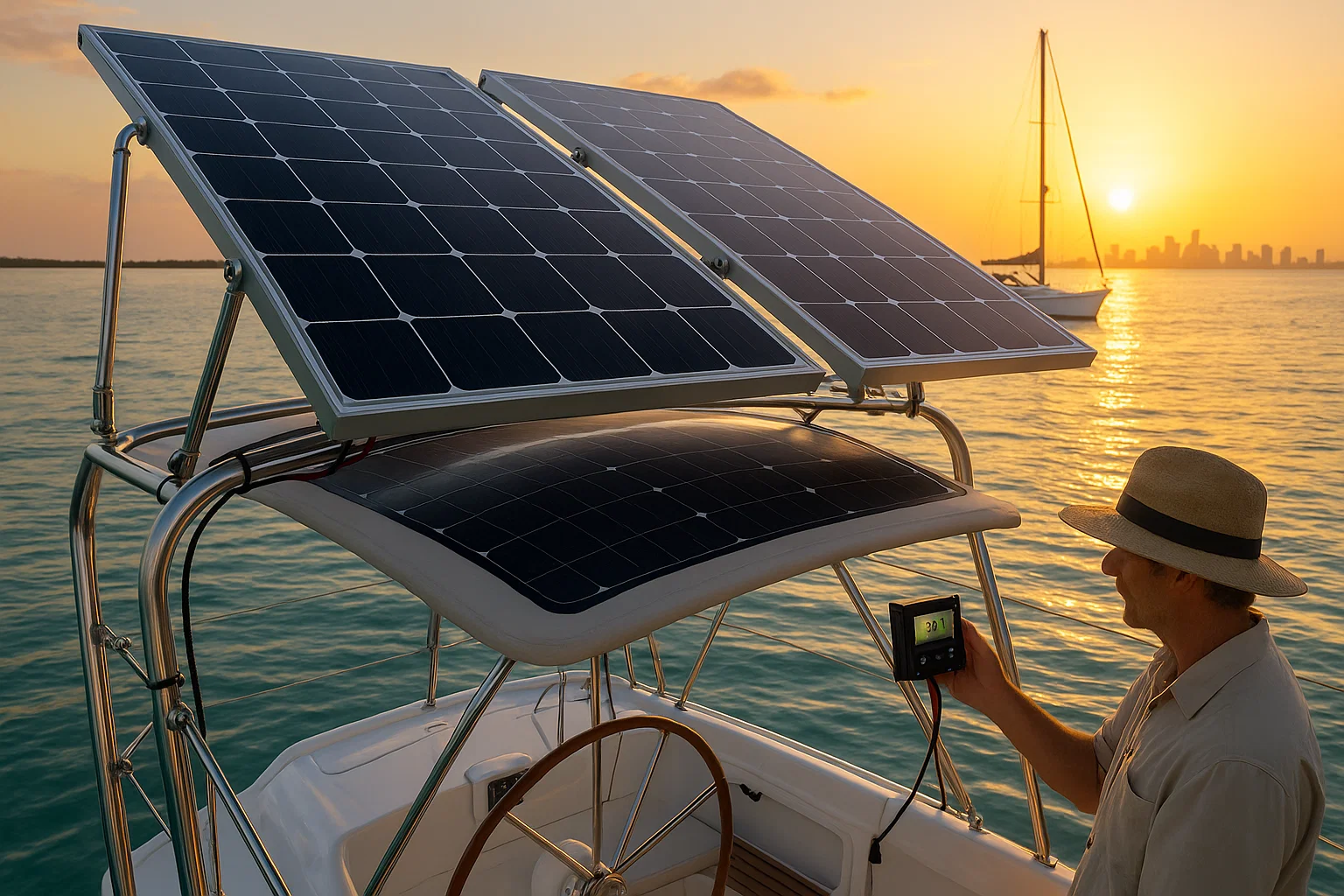It All Started with a Noisy Generator in the Keys
I’ve spent the better part of 20 years with my hands in boat bilges around Miami, and if there’s one sound I hate more than a sputtering engine, it’s the drone of a generator at a quiet anchorage. It’s the soundtrack of being chained to fuel, noise, and maintenance.
I remember a few years back, a guy named Carlos at Dinner Key Marina brought me his Catalina 38. He was fed up. Every evening in the Keys, he’d have to fire up his diesel genset just to keep the fridge cold, and the racket drove him and his neighbors nuts. He wanted freedom. So, we mapped out a 400-watt system of solar panels for his boat. A month later, he called me from the Dry Tortugas, practically shouting into the phone about the silence. He was making coffee with sunshine.
That’s what this is all about. It’s not just about “going green”—though that’s a nice perk. It’s about real independence. It’s about hearing the water lap against the hull instead of a rattling engine.
But here’s the thing: slapping any old solar panel on your boat is a recipe for disaster. The marine world, especially here in Florida, eats gear for breakfast. Salt, UV, constant vibration—it’ll kill a cheap panel faster than you can say “delamination.” Choosing the right gear is everything.
So, in this guide, I’m going to walk you through it all, mechanic-to-boater. No fluff. We’ll cover what makes a good marine panel, what to look for in brands, and how to avoid the common mistakes that cost people a fortune.
Table of Contents
Why Bother with Solar? More Than Just Free Power
Ditching the Generator for Good
That generator noise… nobody likes it. It’s that constant reminder you’re burning fuel just to exist. Putting a good set of solar panels on a boat quiets things down, sometimes for good. That’s the real win.
Built to Survive the Ocean
A boat is a torture chamber for equipment. Panels face challenges land-based systems never dream of:
- Saltwater Corrosion: It gets everywhere and eats cheap metal for lunch.
- Constant Vibration: From engines and waves, shaking connections loose.
- Intense UV: Florida sun is brutal and degrades plastics and coatings.
- Flex and Impact: A dropped winch handle or a heavy foot can shatter a weak panel.
This is why you can’t just buy a residential panel. You need marine-grade hardware: anodized frames, ETFE laminates, and junction boxes sealed up tighter than a submarine hatch (look for IP67 or IP68 ratings). A proper set of solar panels for your boat is an investment in gear that’s built to last out here.

Picking Your Panels: What Really Matters on Deck
Efficiency is King in Tight Spaces
On a boat, you don’t have acres of roof. Every square inch counts. That’s why panel efficiency is critical.
- Monocrystalline: These are your best bet. They offer the highest efficiency (usually 18-25%) and perform better in low light. I’ll admit, brands like SunPower are expensive, but they’ve earned their reputation. They just pull more juice out of the same small space than anything else I’ve installed.
- As for Polycrystalline panels? You’ll see them because they’re cheap, but they’re just not as efficient. I generally tell people to steer clear unless they have a ton of space to spare.
- Flexible Panels: Great for curved biminis or decks, but pay close attention. Cheap PET-coated ones will cloud over and fail in a couple of seasons. Go for the tougher, ETFE-coated flexible panels. They cost more but will actually last.
Rigid vs. Flexible: A Quick Breakdown
I get this question all the time. Here’s my take:
- Rigid Panels: The workhorses. They are the most durable, have the longest lifespan (25+ years), and are generally the most efficient. Best for arches, hardtops, or rail mounts.
- Flexible/Semi-Rigid Panels: The problem-solvers. Perfect for surfaces where you can’t mount a rigid panel. They are lightweight, which is great for reducing weight aloft. Some are even rated to be walked on, but I’d still be careful. The trade-off is usually a shorter lifespan (5-15 years) and slightly lower durability.
When looking at solar panels for a boat, think about where they’ll live and what kind of abuse they’ll take.
The Big Names: Who to Trust on the Water
Not all brands are created equal. I’ve installed dozens of systems and seen which ones hold up and which ones turn into expensive junk.
The Premium Players
- SunPower (Maxeon): The top of the food chain. Insanely efficient and backed by a solid warranty. Their flexible panels are some of the few I actually trust. Pricey, but you get what you pay for.
- BougeRV: A strong contender with some cool tech like bifacial panels that capture reflected light from the deck. Good warranties and solid construction.
The Reliable Workhorses
- Then you’ve got Renogy. They’re everywhere, and for good reason. The gear just works, it doesn’t cost a fortune, and you can get everything you need from them, from the panels down to the fuses.
- EcoFlow & Jackery: Kings of the portable world. Their foldable “suitcase” panels are brilliant for smaller boats or for supplementing a main array at anchor. They are surprisingly efficient and durable (IP67/68).
The Budget-Friendly Options
- Eco-Worthy & NewPowa: If your budget is tight, these brands offer a decent entry point. The quality has gotten better over the years. They are a good fit for smaller, less critical systems. Just be extra diligent about checking the specs and sealing the connections yourself.
It’s a System, Not Just a Panel
Here’s a secret: the world’s best solar panels for a boat are useless without the right supporting gear.
- The Charge Controller: This is the brain. Don’t cheap out here. Get an MPPT (Maximum Power Point Tracking) controller. It will harvest up to 30% more power from your panels than a cheaper PWM controller, especially on cloudy days.
- And batteries? Man, the new LiFePO₄ (lithium) batteries have changed the game for solar. They soak up power way faster and outlive the old lead-acid ones by years. It’s a no-brainer upgrade.
- And let’s talk wiring for a second. If I’ve learned one thing, it’s to never, ever cheap out here. You have to use proper marine-grade tinned-copper wire and seal every single connection. 90% of the weird electrical gremlins I hunt down start at one bad connection.
Shade is your enemy. A shadow from a mast or boom across even one part of a panel can cripple its output. Think carefully about placement. Sometimes, two smaller panels in different locations are better than one big one that gets shaded.
FAQ: Quick Answers I Give at the Dock
How many watts do I need?
So how much power is enough? Well, a weekend boat might only need 200W. But if you live aboard down in the Keys? You could be looking at 800W or more. It all comes down to how you use your boat.
Can I really walk on flexible panels?
Some are rated for it, but I wouldn’t make a habit of it. They are “walkable,” not a dance floor. Every step is a risk.
What’s the biggest mistake people make?
Ignoring shade. They mount a beautiful, expensive array right under the boom, and then wonder why their batteries are always dead.
How do I clean them?
And forget all those fancy cleaners. Just use fresh water and a soft brush. Keep ‘em clean, and they’ll keep making power for you.
So, What’s the Bottom Line?
Look, if you’re going to put solar panels on your boat, this is the stuff that really matters. The advice I give my clients before they write any checks:
- Ditch the Generator for Good: The real prize here is silence and freedom from fuel. A well-designed solar system can make your generator a backup, not a daily necessity.
- Buy Marine-Grade or Cry Later: Saltwater will destroy cheap gear. Look for panels with ETFE coatings, anodized aluminum frames, and high IP ratings (IP67/68). It’s worth the extra money.
- Efficiency Is Your Best Friend: Deck space is limited. High-efficiency monocrystalline panels give you the most power for the space you have.
- Don’t Skimp on the Controller: An MPPT charge controller is a must. It’s the best bang-for-your-buck upgrade you can make to a solar system.
- Check the Warranty: A long warranty (25 years on power output) tells you the manufacturer has faith in their product. A one-year warranty should tell you something, too.
- Know Your Needs First: Before you buy anything, do an energy audit. Figure out how much power you actually use. Sizing your system correctly is the key to being happy with it.
Author Bio
I’m Alex, a 15-year marine technician in South Florida, ABYC-certified. I’ve designed and installed dozens of marine solar systems, from small portable setups on weekend cruisers to full-scale arrays on liveaboard catamarans at marinas like Dinner Key and Bahia Mar, helping boaters find true energy independence.


Leave a Reply